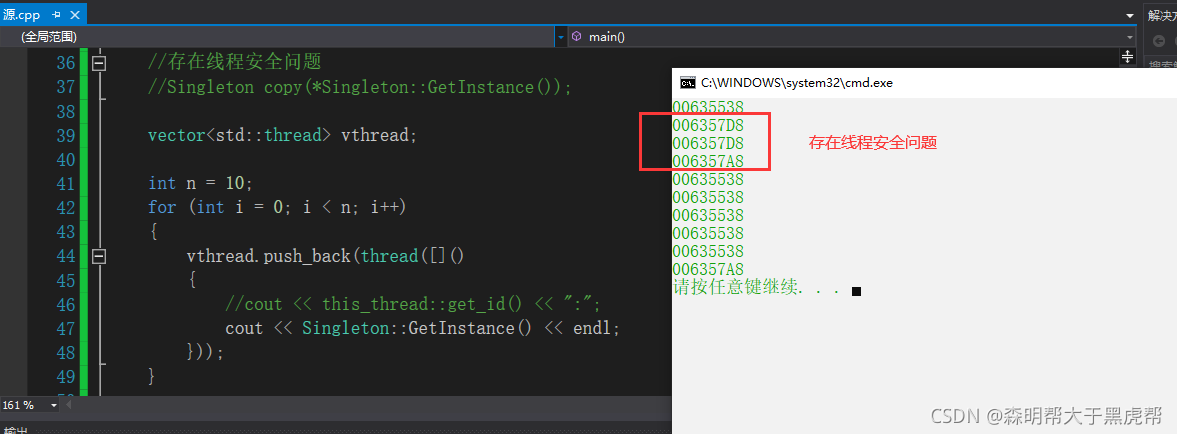
系列文章目录
文章目录
前言
掌握常见特殊类的设计方式。

一、请设计一个类,只能在堆上创建对象
- 实现方式:
- 将类的构造函数私有,拷贝构造声明成私有。防止别人调用拷贝在栈上生成对象。
- 提供一个静态的成员函数,在该静态成员函数中完成堆对象的创建。
#define _CRT_SECURE_NO_WARNINGS 1
#include<iostream>
#include<memory>
using namespace std;
class HeapOnly
{
public:
static HeapOnly* GetObj()
{
return new HeapOnly;
}
private:
HeapOnly()
{}
//C++98声明为私有
HeapOnly(HeapOnly&);
//C++11
HeapOnly(HeapOnly&) = delete;
};
int main()
{
//HeapOnly* p = HeapOnly::GetObj(); 防止内存泄漏,用智能指针
std::shared_ptr<HeapOnly> sp1(HeapOnly::GetObj());
return 0;
}
二、请设计一个类,只能在栈上创建对象
- 方法一:同上将构造函数私有化,然后设计静态方法创建对象返回即可。
- 方法二:屏蔽new,因为new在底层调用void* operator new(size_t size)函数,只需将该函数屏蔽掉即可。注意:也要防止定位new。
#define _CRT_SECURE_NO_WARNINGS 1
#include<iostream>
using namespace std;
class StackOnly
{
public:
static StackOnly GetObj()
{
return StackOnly();
}
private:
StackOnly(){}
void* operator new(size_t size) = delete;
};
int main()
{
StackOnly p = StackOnly::GetObj();
//StackOnly* p = new StackOnly;
return 0;
}
三、请设计一个类,不能被拷贝
- 拷贝只会放生在两个场景中:拷贝构造函数以及赋值运算符重载,因此想要让一个类禁止拷贝,只需让该类不能调用拷贝构造函数以及赋值运算符重载即可。
- C++98:将拷贝构造函数与赋值运算符重载只声明不定义,并且将其访问权限设置为私有即可。
- 原因:
- 设置成私有:如果只声明没有设置成private,用户自己如果在类外定义了,就可以不能禁止拷贝了。
- 只声明不定义:不定义是因为该函数根本不会调用,定义了其实也没有什么意义,不写反而还简单,而且如果定义了就不会防止成员函数内部拷贝了。
- C++11:扩展delete的用法,delete除了释放new申请的资源外,如果在默认成员函数后跟上=delete,表示让编译器删除掉该默认成员函数。
#define _CRT_SECURE_NO_WARNINGS 1
#include<iostream>
using namespace std;
class CopyBan
{
public:
CopyBan()
{}
private:
//只声明不定义,并且设置为私有
CopyBan(const CopyBan&);
CopyBan operator=(const CopyBan&);
CopyBan(const CopyBan&) = delete;
CopyBan operator=(const CopyBan&) = delete;
};
int main()
{
CopyBan a;
CopyBan b(a);
CopyBan c;
c = a;
return 0;
}
四、请设计一个类,不能被继承
C++98:中构造函数私有化,派生类中调不到基类的构造函数。则无法继承。
C++11:方法final关键字,final修饰类,表示该类不能被继承。
#define _CRT_SECURE_NO_WARNINGS 1
#include<iostream>
using namespace std;
class NoInherit final
{
public:
static NoInherit GetInstance()
{
return NoInherit();
}
private:
NoInherit()
{}
};
int main()
{
NoInherit a = NoInherit::GetInstance();
return 0;
}
五、请设计一个类,只能创建一个对象(单例模式)

设计模式:
设计模式( Design Pattern)是 一套被反复使用、多数人知晓的、经过分类的、代码设计经验的总结。 为什么会产生设计模式这样的东西呢?就像人类历史发展会产生兵法。最开始部落之间打仗时都是人拼人的对砍。后来春秋战国时期,七国之间经常打仗,就发现打仗也是有套路的,后来孙子就总结出了《孙子兵法》。孙子兵法也是类似。
单例模式:
一个类只能创建一个对象,即单例模式,该模式可以保证系统中该类只有一个实例,并提供一个访问它的全局访问点,该实例被所有程序模块共享。 比如在某个服务器程序中,该服务器的配置信息存放在一个文件中,这些配置数据由一个单例对象统一读取,然后服务进程中的其他对象再通过这个单例对象获取这些配置信息,这种方式简化了在复杂环境下的配置管理。
#define _CRT_SECURE_NO_WARNINGS 1
#include<iostream>
#include<thread>
#include<vector>
#include<Windows.h>
using namespace std;
class Singleton
{
public:
static Singleton* GetInstance()
{
Sleep(1000);
if (_pinst == nullptr)
{
_pinst = new Singleton;
}
return _pinst;
}
private:
Singleton()
{}
Singleton(const Singleton&);
Singleton& operator=(const Singleton&);
static Singleton* _pinst;
};
Singleton* Singleton::_pinst = nullptr;
int main()
{
//cout << Singleton::GetInstance() << endl;
//cout << Singleton::GetInstance() << endl;
//cout << Singleton::GetInstance() << endl;
//存在线程安全问题
//Singleton copy(*Singleton::GetInstance());
vector<std::thread> vthread;
int n = 10;
for (int i = 0; i < n; i++)
{
vthread.push_back(thread([]()
{
//cout << this_thread::get_id() << ":";
cout << Singleton::GetInstance() << endl;
}));
}
for (auto& t : vthread)
{
t.join();
}
return 0;
}

1.单例模式之饿汉模式
- 饿汉模式
- 就是说不管你将来用不用,程序启动时就创建一个唯一的实例对象。
饿汉模式
优点:简单
缺点:可能会导致进程启动慢,且如果有多个单例类对象实例启动顺序不确定
#define _CRT_SECURE_NO_WARNINGS 1
#include<iostream>
#include<vector>
#include<thread>
using namespace std;
namespace yyw
{
//饿汉模式-- 一开始(main函数之前就)创建对象
class Singleton
{
public:
static Singleton* GetInstance()
{
return &_inst;
}
Singleton(const Singleton&) = delete;
Singleton& operator=(const Singleton&) = delete;
private:
Singleton()
{}
static Singleton _inst;
};
Singleton Singleton::_inst;
//static对象是在main函数之前就创建的,这里只有主线程,所以不存在线程安全问题
int x()
{
//cout << Singleton::GetInstance() << endl;
//cout << Singleton::GetInstance() << endl;
//cout << Singleton::GetInstance() << endl;
//存在线程安全问题
//Singleton copy(*Singleton::GetInstance());
vector<std::thread> vthread;
int n = 10;
for (int i = 0; i < n; i++)
{
vthread.push_back(thread([]()
{
//cout << this_thread::get_id() << ":";
cout << Singleton::GetInstance() << endl;
}));
}
for (auto& t : vthread)
{
t.join();
}
return 0;
}
}
int main()
{
yyw::x();
return 0;
}
2.单例模式之懒汉模式
- 懒汉模式
- 如果单例对象构造十分耗时或者占用很多资源,比如加载插件啊, 初始化网络连接啊,读取文件啊等等,而有可能该对象程序运行时不会用到,那么也要在程序一开始就进行初始化,就会导致程序启动时非常的缓慢。 所以这种情况使用懒汉模式(延迟加载)更好。
懒汉
优点:第一次使用实例对象时,创建对象。进程启动无负载。多个单例实例启动顺序自由控制。
缺点:复杂
#define _CRT_SECURE_NO_WARNINGS 1
#include<iostream>
#include<thread>
#include<vector>
#include<Windows.h>
#include<mutex>
using namespace std;
namespace Lazy_MAN
{
//懒汉模式
class Singleton
{
public:
static Singleton* GetInstance()
{
Sleep(1000); //增加加没加锁时出现线程不安全的情况
//局部域控制解锁时机
//双检查加锁方式,
if (_pinst == nullptr) //第一次判断是防止对象创建好以后,还要每次加锁,就浪费了。
{
//_mtx.lock();
unique_lock<mutex> lock(_mtx);
if (_pinst == nullptr) //第二次判断是为了防止多个线程一起写不安全现象
{
_pinst = new Singleton;
}
//_mtx.unlock();
}
return _pinst;
}
static void DelInstance()
{
//unique_lock<mutex> lock(_mtx);
delete _pinst;
_pinst = nullptr;
}
private:
Singleton()
{}
Singleton(const Singleton&);
Singleton& operator=(const Singleton&);
static Singleton* _pinst;
static mutex _mtx;
};
//1.如果要手动释放单例对象,可以调用DelInstance
//2.如果需要程序结束时,正常释放对象,可以加入下面的对象
class GC
{
public:
~GC()
{
Singleton::DelInstance();
}
};
//定义一个静态成员变量,程序结束时,系统会自动调用它的析构函数从而释放单例对象。
static GC gc;
Singleton* Singleton::_pinst = nullptr;
mutex Singleton::_mtx;
int main()
{
//cout << Singleton::GetInstance() << endl;
//cout << Singleton::GetInstance() << endl;
//cout << Singleton::GetInstance() << endl;
//存在线程安全问题
//Singleton copy(*Singleton::GetInstance());
vector<std::thread> vthread;
int n = 10;
for (int i = 0; i < n; i++)
{
vthread.push_back(thread([]()
{
//cout << this_thread::get_id() << ":";
cout << Singleton::GetInstance() << endl;
}));
}
for (auto& t : vthread)
{
t.join();
}
return 0;
}
}

总结
以上就是今天要讲的内容,本文介绍了一些特殊类设计以及单例模式,特殊类在面试中经常出现,我们务必掌握。另外如果上述有任何问题,请懂哥指教,不过没关系,主要是自己能坚持,更希望有一起学习的同学可以帮我指正,但是如果可以请温柔一点跟我讲,爱与和平是永远的主题,爱各位了。
